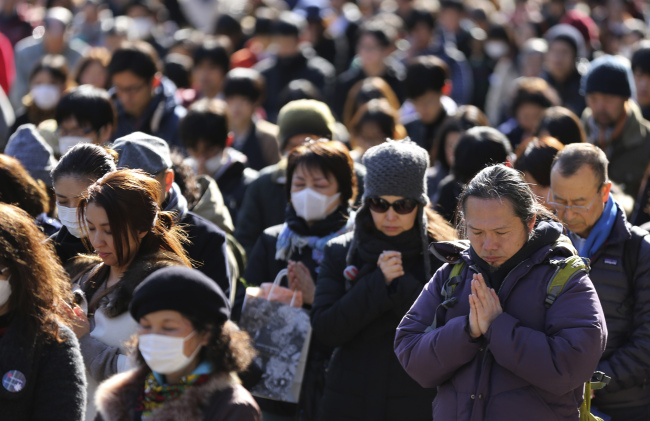FUKUSHIMA, Japan (AFP) ― In complete darkness, a group of men tried everything they could to save the Fukushima nuclear plant from catastrophe. Their struggle was in vain.
Three years later, the control room at the site of the worst atomic crisis in a generation ― which forced a hard look at Japan’s energy policy ― sits as a grim time capsule.
Helmets, masks, several pairs of gloves and overalls remain as reporters are taken on a tour of the inner sanctum, a first since the accident.
Notes are scribbled awkwardly on walls in rooms with levers, dials and buttons, reminders of March 11, 2011, when a towering wall of water plunged the site into darkness and sent reactors into meltdown.
What was happening inside the reactor core was unknown to the workers who fought hour after hour before they were forced to abandon part of the doomed site.
Not far away in the destroyed reactors, radioactivity is so strong that it remains a no-go area.
“The guys that were working here are not at the plant anymore ― they got too much radiation,” said Kenichiro Matsui, an official at Fukushima operator Tokyo Electric Power.
Workers now at the site have yet to even start dismantling the crippled reactors, a process not expected to begin for another six years, part of a decommissioning process expected to stretch over decades.
Several thousand employees are locked in a daily ― and dangerous ― scramble under harsh conditions to keep the site as safe as possible, making a myriad of repairs and building tanks for the vast amounts of contaminated water.
The company poured thousands of tons of water onto runaway reactors to keep them cool, and continues to douse them, but has to store and clean that water in a growing number of temporary tanks at the site.
TEPCO has warned it is running out of storage space and many experts believe the water will eventually have to be dumped into the sea after being scoured of its most harmful contaminants.
Local fishermen, neighboring countries and environmental groups all oppose the idea.
Last year, the embattled firm said around 300 tons of radioactive liquid were believed to have escaped, a serious incident that underscored the litany of ongoing problems at Fukushima.
“The management of this water problem is still not satisfactory,” said Dale Klein, former chairman of the U.S. Nuclear Regulatory Authority and a member of the committee overseeing the plant’s decommissioning.
He added that the “four steps forward, two steps back” progress has hurt confidence in the utility’s crisis management, already under fire since the accident that forced tens of thousands to flee their homes, possibly forever.
The crisis forced the shutdown of Japan’s 50 nuclear reactors, which remain offline as anti-atomic sentiment ripples through communities big and small in the country of 128 million.
 |
People observe a moment of silence at 2:46 p.m. in Tokyo Tuesday, March 11, 2014, three years after a massive earthquake and tsunami struck northeastern Japan. Japan marked the third anniversary on Tuesday of a devastating disasters that left nearly 19,000 people dead or missing. (AP-Yonhap) |
Tens of thousands of citizens turned out for an anti-nuclear rally in Tokyo on Sunday to voice their anger at the nuclear industry and the government of Prime Minister Shinzo Abe, who has called for resumption of reactors to power the world’s third-largest economy.
Abe repeated his view Monday that any reactors which can be deemed safe would be turned back on, burying a move by the previous government to make Japan a zero-nuclear country by 2040.
But critics say that TEPCO’s clumsy management of the crisis and wider concerns about the accident ― including long-term health fears ― should keep the reactors turned off for good.
“Prime Minister Abe and the nuclear industry are hoping the Japanese people and the world will forget the victims and the terrible lessons of Fukushima, hoping that they will allow the restart of old, risky reactors,” said Junichi Sato, executive director of Greenpeace Japan.
“What we should instead forget is an energy system that is dependent on old, dirty, and dangerous technologies like nuclear and fossil fuels.”
The government has backed a push into solar power and wind farms, among other renewable energy sources, but they still make up a tiny portion of Japan’s energy needs.
The loss of nuclear power, which once supplied more than a quarter of Japan’s power, has also created huge trade imbalances owing to surging imports of fossil-fuel alternatives to plug the energy gap, made all the more expensive as the yen weakened sharply since Abe swept to office in 2012.
Another issue is that the move to fossil fuels has stoked worries that Japan would not meet its commitment to cut greenhouse-gas emissions, while making it more dependent on other nations for its energy security.








